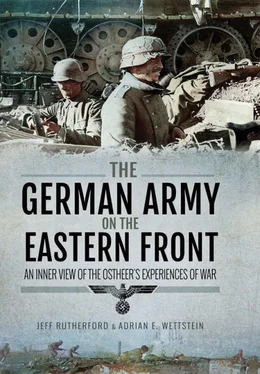c) In all branches the recruits must be educated to hardness . This hardness must find its expression in the will and the ability to bear hardships, such as long marches, simple quarters, meagre rations and inhospitable climate, and in the determination and self-confidence that are also necessary to carry forward an attack against a stronger opponent until the enemy’s destruction and to hold one’s ground in the defence against an opponent superior in number and weapons. […]
d) Prepare the recruits of all branches on the combat practices of the opponent, especially on the possibility of raids at any time, day or night, and at every opportunity. This training must be handled, so that after the basic training the soldier cannot be confounded by anything and is not surprised by even a very unusual situation.
In addition to these general guidelines, the issues most important for each specific type of formation were also transmitted within each unit. Those for the infantry and motorized infantry are compiled below:
The following areas of training are to be carried out with special emphasis:
1) Observation of the combat area, recognition and addressing of targets, becoming familiar with the terrain, and estimation of distances.
2) Orientation in terrain day and night without maps, with simple sketches, compass, by sun and stars.
3) Reconnaissance patrol and stealth exercises […]
4) In the attack, use of one’s own heavy weapons and artillery fire or artificial fog to advance. During a break-in, firing on the move and assaulting with the will to destroy the enemy who does not surrender in close combat. Increased close combat training with all available means and weapons. […]
5) Combat in woods and for and in villages is to be increasingly practiced.
6) Night training and training in fog to acclimatise the recruit to these types of combat are especially necessary. While doing so, seeing, hearing, movement and orientation at twilight and during the night, reconnaissance patrol missions, attacks, raids and defence against them, security and sentry service.
7) Defence: Construction of the position according to [Infantry Training] Manual 130/11 with a considered adaptation to the terrain, skilful camouflage and use of spade. Increased use of changing positions for light machine guns and all heavy infantry weapons. Educate [the men] that there could be big holes by neighbour[ing units] in the defence of broad front sections, which have to be mastered by fire, sealing off and counter attacks. The enemy who has broken into our positions also has to be destroyed by heavy weapons in close combat. The positions of heavy weapons, especially anti-aircraft guns, are to be selected as 360 degree defence. […]
8) Defence against tanks. No tank fright can arise among the infantry. He must know that he is protected in the tank foxhole and that he is in the position to destroy tanks with his equipment. […]
9) Fire effectiveness with all weapons is to increase. The primary emphasis should be placed on combat firing exercises [2]against well camouflaged targets. Also firing at twilight or in the night is to be especially practiced. Every recruit must master his weapon to perfection even under the most difficult situations. The training with the M.G. 34 is to be promoted with stronger emphasis. Care and maintenance of weapons are an important area of training. Good riflemen are to be trained with the telescopic sight and the semi-automatic rifles.
10) The defence against aircraft with infantry weapons is of special importance. Air attacks are not to be passively endured. […]
11) Marches are not only carried out on roads, but also on lanes and cross country with available equipment. In principle, all marches are to combine a tactical idea with constant combat exercises. Night marches are to be practiced often.
12) Physical exercises are to be adapted to the training area, for example, cross country running for habituation to continuous activity, hand grenade throwing in regards to close combat and so on.
German basic training aimed for soldiers who mastered their weapons, could work together with other weapons and types of units, had an eye for the terrain, and could act independently, the last being a general principle of the German army since the pre-First World War era. Issues especially stressed as a consequence of the campaign in the east included defensive positions, unit defence against tanks and aircraft, and night fighting. Such issues had rarely arisen in the short campaigns of 1939 and 1940, as German forces were primarily on the offensive, encountered few enemy attacks and profited from air superiority, if not air supremacy. In the east, many units already had to go over to the defensive temporarily in the first months, as demonstrated in chapter 1. The sheer size of the theatre, as well as the fluidity of the combat situation, did not allow for a continuous front line, and so many advancing German units were attacked by Soviet tanks or aircraft. The Red Army was also more accustomed to night fighting. Additional issues that became important were described in chapter 3.
Men trained in the Replacement Army were formed into march battalions, numbering up to 1,000 men, to be sent to the front. The German army was organized territorially, which meant that German divisions were connected to a clearly defined area from which to draw recruits. The replacement units functioned as an intermediate level between the field unit and the recruitment area. So, for example, the 73rd Infantry Division originated from Military District XIII (Nuremberg), which consisted primarily of Franconia. Its Infantry Regiment 170 received replacements from Infantry Replacement Battalion 170, its Artillery Regiment from Artillery Replacement Battalion 173, and its Engineer Battalion from Engineer Replacement Battalion 17. This connection was vitally important for the combat power of the German army. Field units were bound to a territory, allowing them to draw from the traditions and symbols of that region. It also enhanced the units’ cohesion, as soldiers from the same region shared comparable values and identities. [3]This explains the relatively high effort the army directed towards maintaining this system. Furthermore, the ties between the field and replacement units allowed for an exchange of personnel, which increased the realistic nature of combat training, as well as giving war-weary men an opportunity to take a break from the front. Finally, and perhaps most importantly, the men trained in the replacement units were already acquainted with the men with and under whom they would fight in future. So, integration into the field unit started with basic training, an important factor for the unit’s cohesion.
There was a second type of replacement unit, the so-called convalescent companies. These consisted of men so severely wounded or ill that they had to be sent back to Germany for recuperation and recovery. They were collected and retrained (or used as trainers, depending on their rank) at the replacement unit and then sent forward. These men, combat experienced and already well integrated into their units, were of high value for the divisions. Only officers and a few specialists were sent individually or in small groups to the front.
This system worked well during the short campaigns of 1939 to 1941, when periods of quick, intensive operations alternated with longer periods of rest and refitting. Few replacements had to be integrated during an operation or campaign, and if this was carried out in a defective manner, it had only a minor impact. The moulding and training of new low-level leaders, as well as specialist training, was carried out between campaigns and not within the framework of combat divisions, but instead in the Replacement Army. This idea prevailed in the German military apparatus in summer 1941, since the German military leadership expected another short campaign. As it became clear in autumn 1941 that at least a second campaign would be necessary in 1942 to finally destroy the Red Army, the first adjustments were planned. But at this stage, the massive losses in men and leaders, combined with the permanent logistical crisis – which did not allow the movement of replacements in significant numbers – led to a near collapse of the German replacement system. In response, the German military expanded the Replacement Army. In 1941, for every soldier in the Replacement Army, three were in the Field Army; by 1942, this ratio approached two soldiers in the Field Army for one in the Replacement Army. Therefore the Replacement Army was expanded by 50 per cent in size. [4]This quantitative expansion and the demands for replacements from the front troops had consequences for the quality of the replacements, which increasingly became a source of complaints by field units, as the following sources from 1942 show. The first is from Engineer Battalion 173, subordinated to 73rd Infantry Division, fighting in the Novorossiysk area: [5]
Читать дальше






![John Stieber - Against the Odds - Survival on the Russian Front 1944-1945 [2nd Edition]](/books/405234/john-stieber-against-the-odds-survival-on-the-russian-front-1944-1945-2nd-edition-thumb.webp)





